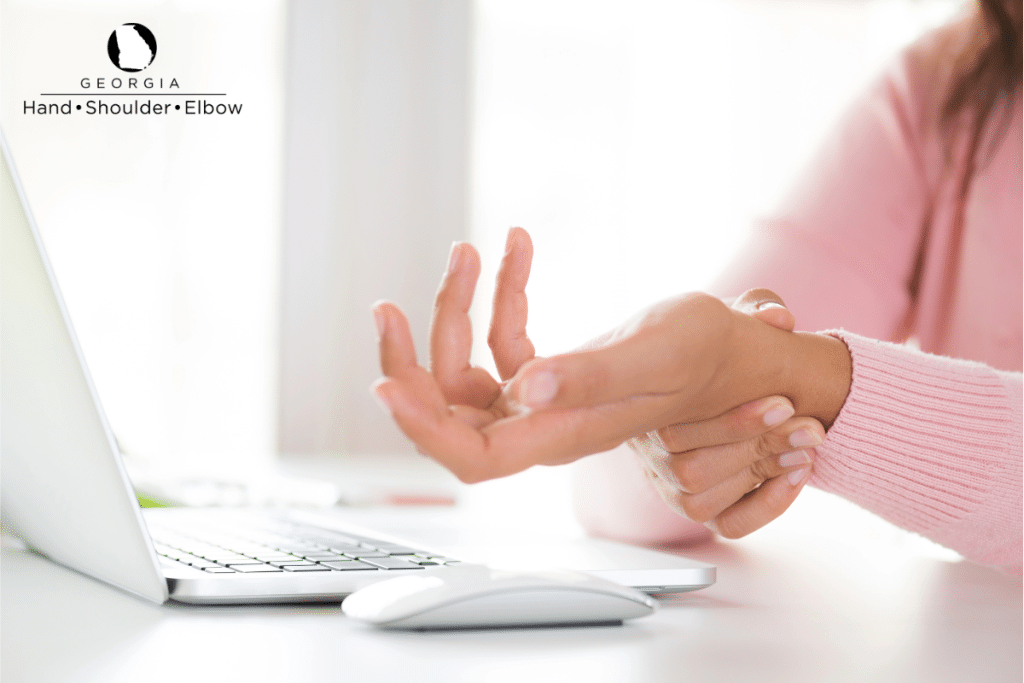
Ganglion Cyst Surgery: What to Expect and How to Prepare
Considering ganglion cyst removal? Learn what to expect before, during, and after surgery, and how Georgia Hand, Shoulder & Elbow in Atlanta, GA can help restore comfort and mobility.
Patient Portal: Effective June 2nd, the practice is using Epic’s MyChart medical record and the Athena portal is no longer available. If you are not on MyChart, please call 404-352-3522 for assistance.
Here at Georgia Hand, Shoulder and Elbow we strive to educate as well as treat our patients. On this page you will find our blog posts which contain educational articles as well as the latest news from our office.

Considering ganglion cyst removal? Learn what to expect before, during, and after surgery, and how Georgia Hand, Shoulder & Elbow in Atlanta, GA can help restore comfort and mobility.

Experiencing cold fingers? Learn the potential vascular causes, symptoms, and treatments, and how Georgia Hand, Shoulder & Elbow in Atlanta, GA can help improve circulation and hand health.

Experiencing shoulder and neck pain linked to elbow nerve issues? Learn how cubital tunnel syndrome may cause radiating pain and find expert diagnosis and treatment at Georgia Hand, Shoulder & Elbow.

Experiencing wrist pain from using a mouse? Learn the causes, prevention tips, and treatment options from the experts at Georgia Hand, Shoulder & Elbow.

Discover how occupational therapy can effectively manage cubital tunnel syndrome, from non-surgical treatments to post-surgery rehabilitation in Atlanta, GA.

Discover how to manage swelling in fingers after wrist surgery. Learn recovery tips and expert advice from Georgia Hand, Shoulder & Elbow in Marietta, GA.

Discover how immobilization devices like wrist braces and splints can alleviate wrist pain caused by ganglion cysts. Contact Georgia Hand, Shoulder & Elbow.

Learn how to properly tape tennis elbow and get relief with kinesiology tape. Schedule a visit with our specialists at Georgia Hand, Shoulder & Elbow.

Struggling with cycling shoulder pain? Learn how posture, bike setup, and exercises can ease discomfort with the experts at Georgia Hand, Shoulder & Elbow.

Pickleball is an increasingly popular sport enjoyed by people of all ages and skill levels. However, like any physical activity, pickleball carries the risk of injury.

Trigger finger, also known as stenosing tenosynovitis, limits your range of motion and can cause a snapping sound when you bend or extend your finger…

At Georgia Hand, Shoulder & Elbow, located in Atlanta and Marietta, we want to help you understand your surgical procedure and quickly recover…

On Saturday, November 10th, 2017 the surgeons at Georgia Hand, Shoulder & Elbow (GHSE) partnered with the Touching Hands Program to lead the first domestic service project that was sponsored by the American Foundation of Surgery of the Hand.

The entire staff here at Georgia Hand, Shoulder, and Elbow was able to witness the Solar Eclipse from our very own rooftop. We all gathered with our glasses and were blown away by this spectacular phenomenon!

Let’s go Braves!! After a week-long Hurricane, our staff had a blast watching the Atlanta Braves play at their new stadium while soaking in the warm rays of the sun.

On Saturday, November 9th, 2019 the third annual Hand2Hand event in association with the American Society for Surgery of the Hand’s “Touching Hand Project” was hosted by Georgia Hand, Shoulder, and Elbow…

In light of recent developments with regards to COVID-19, we are canceling our conference planned for June of this year. We appreciate your support and look forward to seeing you next year!

We hope you will join us at our 2019 Continuing Education Conference at the Georgia Tech Global Learning Center in Atlanta, GA.